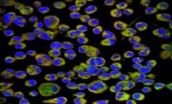(Press-News.org) A team of Melbourne researchers has shown a recently discovered type of cell death called necroptosis could be the underlying cause of inflammatory disease.
The research team discovered that a previously identified molecule involved in necroptosis, called RIPK1, was essential for survival by preventing uncontrolled inflammation. This finding could lead to future treatments for inflammatory diseases including Crohn's disease, rheumatoid arthritis and psoriasis.
The researchers, from the Walter and Eliza Hall Institute, also discovered that the 'survival' molecule RIPK1 acts as the 'gatekeeper' between cell life and death. In a paper published in the journal Cell, they reveal RIPK1 is essential for a cell's decision to live or die, and in choosing how to die.
Institute researchers Associate Professor John Silke, Dr Motti Gerlic and Dr Ben Croker led the project, working with PhD students Mr James Rickard, Ms Joanne O'Donnell and Mr Joseph Evans. Associate Professor Silke said the team had shown for the first time that RIPK1 (receptor interacting protein kinase 1) was a master controller of cell life and death.
"We showed that, in the body, RIPK1 is not only essential for initiating necroptosis, but also for inhibiting necroptosis and the runaway inflammation that can cause severe tissue damage," Associate Professor Silke said. "We also found that it played a role in another type of programmed cell death called apoptosis. Our research highlighted that RIPK1 is the gatekeeper that controls whether a cell lives or dies, and the decision it makes on how to die."
Necroptosis is a type of 'controlled' death that instructs a cell to die while stimulating an inflammatory reaction to let the immune system know something has gone wrong. However when this cell death pathway begins to spiral out of control, it can lead to inflammatory disease. Necroptosis has also been implicated in neurodegenerative disease, brain injuries caused by blood loss, and some viral infections.
Dr Gerlic said their study provided the first evidence that RIPK1 was essential for inhibiting necroptosis.
"This research puts a new dogma on the table about RIPK1 and its role in controlling or inhibiting necroptosis," Dr Gerlic said. "It is also the first time that we have shown necroptosis and the molecules involved actually induce inflammatory disease, suggesting that targeting this pathway could be useful for treating human conditions such as psoriasis, rheumatoid arthritis and Crohn's disease."
Associate Professor Silke said necroptosis was a newly discovered type of cell death that had only really been studied in the past five years. "When our time comes to die, we don't have a choice," he said.
"However cells make this choice all the time – not only whether they die, but also how they die. They can choose to die quietly, or they can make a fuss. Necroptosis is their way of letting everyone else know that they are dying and help is needed usually when something has gone wrong such as a viral infection."
Dr Gerlic said the research team had also shown RIPK1 played other important roles in the body. "As part of the research we found that RIPK1 was essential for keeping blood stem cells alive after bone marrow transplant," he said. "This finding is particularly important when considering treatments that target RIPK1, as it could have unwanted side-effects for other cells in the body. Therefore it is important to ensure any potential drugs are properly investigated for any off-target effects."
Associate Professor Silke said the institute was already capitalising on its expertise in necroptotic cell death with a drug discovery program to identify small molecules that could target molecules downstream of RIPK1 in the necroptotic pathway, such as MLKL (mixed lineage kinase domain-like).
INFORMATION:
The research was supported by the Australian National Health and Medical Research Council, Thomas William Francis & Violet Coles Trust and the Victorian Government. Mr Rickard and Ms O'Donnell are enrolled as PhD students through The University of Melbourne, and Mr Evans is enrolled through La Trobe University.
Link found between cell death and inflammatory disease
2014-05-12
ELSE PRESS RELEASES FROM THIS DATE:
HADES searches for dark matter
2014-05-12
Although Dark Energy and Dark Matter appear to constitute over 95 percent of the universe, nobody knows of which particles they are made up. Astrophysicists now crossed one potential Dark Matter candidate – the Dark Photon or U boson – off the list in top position. This is the result of recent HADES experiments, where researchers from the Helmholtz-Zentrum Dresden-Rossendorf (HZDR) and from 17 other European institutes try to pin down the nature of Dark Matter. These negative results – recently published in Physics Letters B – could even lead to challenges of the Standard ...
Artificial magnetic bacteria 'turn' food into natural drugs
2014-05-12
Scientists from the University of Granada have successfully created magnetic bacteria that could be added to foodstuffs and could, after ingestion, help diagnose diseases of the digestive system like stomach cancer. These important findings constitute the first use of a food as a natural drug and aid in diagnosing an illness, anywhere in the world.
The researchers—members of Bionanomet, the Metallic Bionanoparticle research group of the Department of Inorganic Chemistry and the Institute of Biotechnology of the University of Granada—have conducted this research in collaboration ...
Recombinant adenovirus-mediated 3β-hydroxysteroid-Δ24 reductase inhibits neural apoptosis
2014-05-12
3β-Hydroxysteroid-Δ24 reductase (DHCR24) is a multifunctional enzyme that localizes to the endoplasmic reticulum and has neuroprotective and cholesterol-synthesizing activities. DHCR24 overexpression confers neuroprotection against apoptosis caused by amyloid β deposition. Dr. Xiuli Lu and colleagues from Liaoning University in China constructed two recombinant adenoviruses (Ad-rSYN1-DHCR24-myc and Ad-hSYN1-DHCR24-
myc) that drive DHCR24 expression specifically in neuronal cells. They also found that adenovirus transfection inhibits apoptosis through scavenging ...
Endocrine disruptors impair human sperm function
2014-05-12
HEIDELBERG, 12 May 2014 – A plethora of endocrine-disrupting chemicals interfere with human sperm function in a way that may have a negative impact on fertilization. These are the findings of a German - Danish team of researchers from the Center of Advanced European Studies and Research in Bonn, Germany, and the University Department of Growth and Reproduction, Rigshospitalet, Copenhagen, Denmark. The work, which is published in EMBO reports, suggests that endocrine disruptors may contribute to widespread fertility problems in the Western world in a way that hitherto has ...
Ultra-fast, the bionic arm can catch objects on the fly
2014-05-12
With its palm open, the robot is completely motionless. A split second later, it suddenly unwinds and catches all sorts of flying objects thrown in its direction -a tennis racket, a ball, a bottle-. This arm measures about 1.5 meters long and keeps an upright position. It has three joints and a sophisticated hand with four fingers. It was programmed at the Learning Algorithms and Systems Laboratory at EPFL (LASA) and designed to test robotic solutions for capturing moving objects. It is unique, as it has the ability to catch projectiles of various irregular shapes in less ...
Children of nicotine-addicted parents more likely to become heavy smokers
2014-05-12
VIDEO:
The more time a child is exposed to a parent addicted to smoking, the more likely the youth will not only take up cigarettes but also become a heavy smoker,...
Click here for more information.
WASHINGTON -- The more time a child is exposed to a parent addicted to smoking, the more likely the youth will not only take up cigarettes but also become a heavy smoker.
So warns a team of researchers led by Georgetown Lombardi Comprehensive Cancer Center scientists in Pediatrics. ...
ADHD treatment associated with lower smoking rates
2014-05-12
DURHAM, N.C. -- Treating attention deficit hyperactivity disorder (ADHD) with stimulant medication may reduce smoking risk, especially when medication is taken consistently, according to an analysis led by researchers at Duke Medicine.
The findings appear online May 12, 2014, in the journal Pediatrics.
"Given that individuals with ADHD are more likely to smoke, our study supports the use of stimulant treatment to reduce the likelihood of smoking in youth with ADHD," said senior author Scott Kollins, Ph.D., professor of psychiatry and behavioral sciences and director ...
US cervical cancer rates higher than previously reported, especially among older women
2014-05-12
BALTIMORE – May 12, 2014. Cervical cancer rates in the United States are higher than previously believed, particularly among 65- to 69-year-old women and African-American women, according to a study led by a researcher at the University of Maryland School of Medicine published in the journal Cancer. Current U.S. cervical cancer screening guidelines do not recommend routine Pap smears for women over 65 if their prior test results have been normal.
Previous research finds an age-standardized rate of about 12 cases of cervical cancer per 100,000 women in the United States, ...
New research sets stage for noninvasive monitoring of HIV-induced peripheral neuropathy
2014-05-12
Philadelphia, PA, May 12, 2014 – Corneal nerve fiber assessment has great potential as a tool to diagnose and monitor peripheral neuropathy induced by HIV, say scientists at the Johns Hopkins University School of Medicine. The results of their study are published in The American Journal of Pathology.
Although corneal nerve assessments have shown increasingly valuable as a replacement for epidermal nerve fiber evaluation in diabetic peripheral neuropathy, the evaluation of corneal alterations in tracking HIV-induced neuropathy has yet to be explored.
"The cornea is ...
Current guidelines underestimate US cervical cancer incidence and older women's risk
2014-05-12
Rates of cervical cancer in American women may be higher than previously thought, and the disease may arise most often at an age when adequately screened women are advised to stop getting screened. The findings come from a new study published early online in CANCER, a peer-reviewed journal of the American Cancer Society. The results should be taken into consideration when the national guidelines for cervical cancer screening are reviewed.
Removal of the uterine cervix through a hysterectomy eliminates a woman's risk of developing cervical cancer, but previous estimates ...




